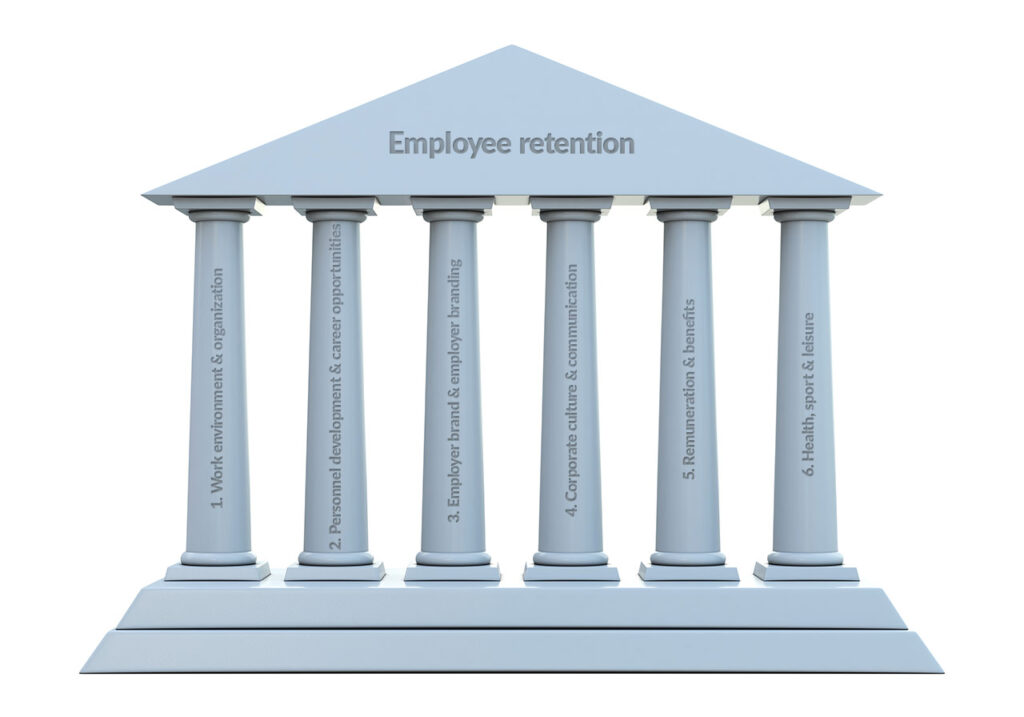
Pillar 1: Work environment and organization
The first pillar of employee retention is about the working environment and work organization. These play an important role in employee retention.

A pleasant and supportive working environment promotes the well-being of employees and helps them to feel valued and respected. This can have a positive impact on their satisfaction, motivation and commitment.
In addition, a well-organized work structure enables employees to work efficiently and complete their tasks successfully.
Clear communication, transparent processes and clear responsibilities also create trust and security among employees.
In addition, flexible working hours, home office options and other forms of work organization can help employees achieve a better work-life balance.
This is an important factor for employee satisfaction and can strengthen their loyalty to the company.
Possible measures:
- Flexible working models
- Canteen
- Clean offices
- Free drinks
- Offer recreation rooms
Pillar 2: Personnel development and career opportunities
The second pillar of employee retention focuses on the professional development and advancement of employees.

When companies offer their employees opportunities for professional development and advancement within the company, employees feel valued and feel that their employer is interested in their long-term professional development.
In addition, clear career opportunities and development prospects can help employees stay in their positions long-term and identify with the company.
They see their future within the company and are less inclined to look for other employment opportunities.
Possible measures:
- Offer internal mentoring
- Offer training and educational measures
- Promote knowledge transfer
- Conduct regular feedback and career discussions
- Create individual development plans
Pillar 3: Employer brand and employer branding
This pillar is an area that has a direct impact on employee retention.
A strong employer brand and effective employer branding help to position the company as an attractive employer and improve employee perception.

This motivates employees to be proud of their work and their company, which in turn strengthens loyalty to the company.
A positive image of the company as an employer can also help to attract talented employees and retain them in the long term.
The employer brand and employer branding are therefore important tools for increasing employee loyalty.
Possible measures:
- Presence on social media
- Use employer review platforms
- Use employees as brand ambassadors
- Offer an open day
- Participation in career fairs
Pillar 4: Corporate culture and communication
Corporate culture and corporate communication are another pillar of employee retention.
Why?
Positive corporate communication, clear corporate values and a harmonious working atmosphere are of great importance in order to strengthen employees’ identification with the company and promote their long-term commitment.
When employees feel that their values are aligned with those of the company and that they are working in a supportive and pleasant environment, their motivation and satisfaction increases.

But how can this be achieved?
A positive corporate culture is characterized by open communication, mutual respect and teamwork.
It is important that employees feel that they are heard and that their opinions and ideas are valued.
Clear corporate values give employees orientation and help them to identify with the company’s mission and vision.
A good working environment creates an atmosphere of trust and cooperation. Employees must feel comfortable and be able to support each other. This increases productivity and the willingness to commit to the company in the long term.

In addition, open and transparent communication on the part of the company plays another important role in employee retention.
It is very important that employees are informed about important decisions, changes and developments within the company.
Clear and honest communication makes employees feel valued and taken seriously.
They have the feeling that their opinion is heard and that they are part of the overall process. This creates trust and strengthens employee loyalty to the company.
Transparent communication also promotes understanding of business decisions and enables employees to actively contribute and help shape them.
Possible measures:
- Introduce a feedback culture
- Open communication
- Clearly defined corporate values
- Transparent management style
- Introduce a culture of success
Pillar 5: Remuneration and benefits
Remuneration and additional benefits also play a decisive role in employee retention.
Appropriate and competitive remuneration shows employees that their work is valued and helps to increase their motivation and satisfaction.

When employees feel they are fairly compensated, they are more likely to stay with the company.
In addition to an appropriate basic salary, additional benefits such as bonuses, company pension schemes, health benefits, flexible working time models or further training opportunities can also strengthen employee loyalty.
These benefits show employees that the company cares about their well-being and invests in their professional development.
This not only makes them feel financially rewarded, but also valued and supported in their personal and professional development.
This can greatly increase employee motivation and loyalty and ultimately strengthen employee retention.
Possible measures:
- Company pension scheme
- Bonuses
- Vacation and/or Christmas bonus
- Travel allowances
- Vouchers
Pillar 6: Health, sport and leisure
Health, sport and leisure is the sixth and final pillar of employee retention.

By offering programs and initiatives to promote the health and well-being of their employees, companies can strengthen their loyalty to the company.
By providing health and wellness programs as well as sports and recreational opportunities, companies show that they care about the well-being of their employees.
This can help to increase employee engagement and satisfaction.
In addition, such programs can also help reduce stress, improve work-life balance and promote overall well-being.
Employees who feel healthy and have the opportunity to relax and exercise in their free time are often more motivated and productive.
This can also improve the working atmosphere and foster a sense of community among employees.
Possible measures:
- Company sport
- Nutritional advice
- Vaccination campaigns
- Health days
- Subsidies for gyms and sports facilities
- Company health management
Conclusion: Employees come first – not customers
In this article, I have explained the 6 pillars that are crucial for retaining employees in a company. These 6 pillars should show you which areas you can invest in to influence employee retention in your company.
Remember that employees have a significant impact on the success of the company.
When employees are happy, feel valued and identify with the company, they are more motivated and committed.
This ultimately has a positive impact on customer satisfaction, customer loyalty and the company’s image.
Strong employee retention should therefore be pursued as a strategic goal, as it is a key factor in the long-term success of a company.
More on the topic of employee retention
- Why employee retention is more important than ever
- 6 methods to measure employee retention
- Employee Net Promotor Score (eNPS): measuring employee loyalty
- 8 measures to increase employee retention
- The turnover rate: a key figure for measuring employee retention
- How surveys can help reduce employee turnover!
- The sickness absence rate: an indicator of employee loyalty
- How surveys can help reduce the sickness rate!
- 6 KPIs and metrics for measuring employee retention





